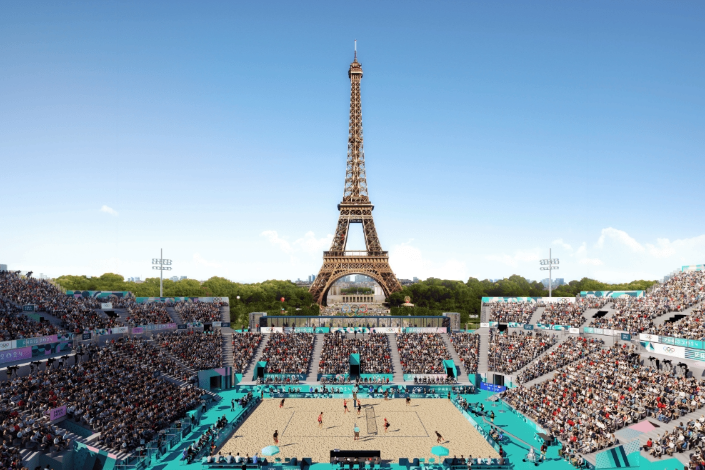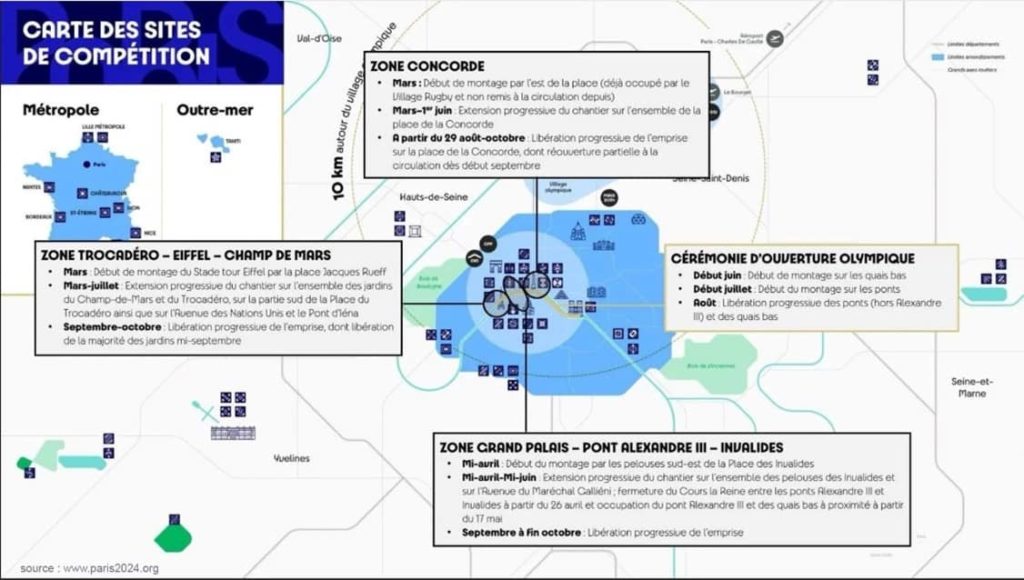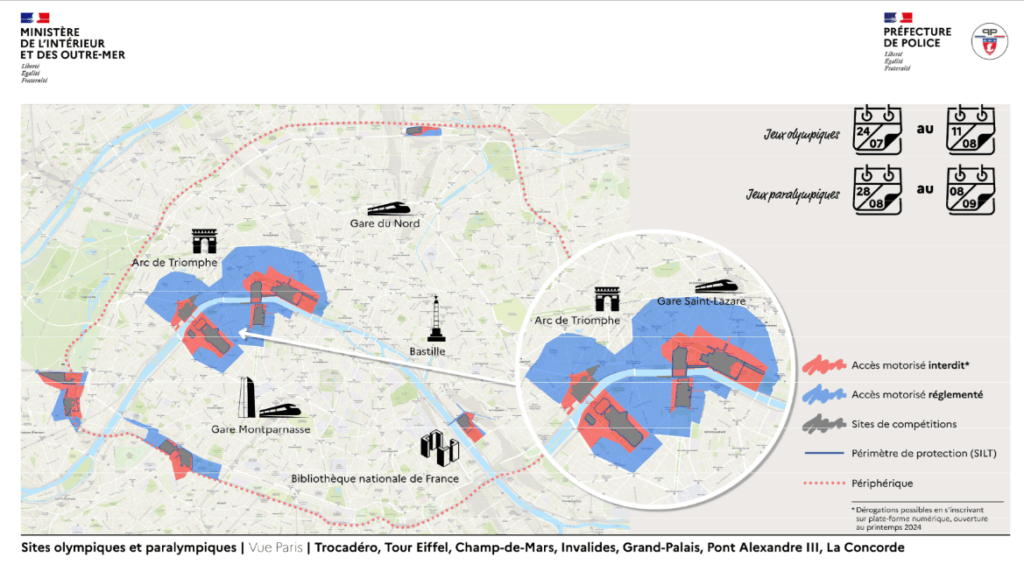Driving through Paris during the summer of 2024 : a nightmare for itinerant professionals ?

Moving and parking in Paris is never easy for professionals such as craftsmen, delivery staff, installers, technicians, home care aides and many others who rely on vehicles on a daily basis. The prospect of this sports event in 2024 is rightly worrying, especially since the security measures revealed by the Prefect of Police of Paris at the end of November will significantly disrupt traffic conditions in Paris, its immediate suburbs, and on certain main lines serving the capital. Unfortunately for traveling professionals, the challenges will start well before the first events…
8 Complicated months ahead
Before discussing the general configuration and restricted traffic areas, it is essential to note that the disruptions will not be limited to the duration of the events (July 26 to August 11, 2024) and Paralympic (August 28 to September 8, 2024). It is necessary to consider the phases of setting up and dismantling temporary sites and installations, which will occupy the hypercenter of Paris (see the map below). Judging from the provided representations, this process will take more than a day…

Crédit Paris 2024
Keep in mind that the setup phase will extend from March to July 2024, with significant impacts on traffic (access and transit) at various critical points. For example, the first consequences on traffic will be felt as early as March in the Champ de Mars area, starting May 17 for Place de la Concorde, and from May 1 for the Trocadéro area. It’s worth noting that several days before the opening ceremony on July 26, almost all quays and roads along the Seine will be closed to motorized traffic.
Regarding dismantling, the schedule is still being defined. The State and the City of Paris aim to free up spaces as quickly as possible. In this regard, dismantling will start at the end of the last competitions at each site. It will be completed no later than the end of October 2024, with the total release of public space.
In short, from March to October 2024, those who have no choice but to travel in Paris to deliver goods, transport people, or serve clients will need patience and, most importantly,
>> Stay constantly informed about ongoing and upcoming operations on the website of the Paris police prefecture or the City of Paris website.
>> Adapt their routes and movements as much as possible based on this information.

>> Inform their clients (individuals, businesses, or companies) as early as possible about date and time changes due to these disruptions.
The operational framework during the events
Rest assured, the event will not immobilize Paris ! This is simply inconceivable considering the expected 11 million tourists who will need transportation, food, accommodation, and, if necessary, assistance and medical care. The goal of the authorities is to “ensure the safety of residents, Parisians, and spectators during this event while allowing social, economic, and cultural activities to continue under the most satisfactory conditions” (source: police prefecture). Nevertheless, working in Paris during the events will require mobile/itinerant professionals to have additional organization and planning.
1 – Security perimeters

Four perimeters apply to each site hosting events or related activities in Paris, Seine-Saint-Denis (where the Stade de France and the Olympic Village are located) and the rest of the Île-de-France region. Each perimeter has specific access and traffic conditions for motor vehicles, illustrated by the example below.
Important note: The perimeters are not permanent, except around the Olympic Village. They are activated 2.5 hours before the start of the events to be held there and deactivated 1 hour after they end. The schedule of events is, therefore, an essential tool for those who need to travel by motor vehicle. At this stage, the schedule does not specify the times or locations of the various competitions. It’s up to you to correlate this information with the map of locations assigned to different disciplines.
- In gray, the “organizer” perimeter corresponds to the competition site itself. It is only accessible to ticket-holding spectators and individuals accredited by the organization.
- The Security periphery Silt (Internal Security and Anti-Terrorism Law), marked by a blue line, generally coincides with the previous one. Anyone wishing to access it is searched by law enforcement.
- The red perimeter prohibits motorized traffic (4 wheels and 2 wheels), except with a derogation (see below), to secure pedestrian flows to and from the event. Pedestrians and cyclists can move freely within it.
- The blue perimeter is a regulated traffic zone. Its goal is to reduce motorized flows around the red perimeter by diverting transit traffic. Only drivers who can justify a need for access (delivery, breakdown, moving, home or work access) will be able to circulate there.
Maps of the Paris police prefecture specifying the perimeters for each site, the opening ceremony, and road events (marathon and cycling) can be downloaded here :
https://www.prefecturedepolice.interieur.gouv.fr/perimetresJOP
2 – Reserved lanes
For months now, Parisians and more broadly Ile-de-France residents have been worried about the establishment of lanes on several roads reserved for the circulation of athletes, rescuers, officials, taxis and public transport. Some routes will be permanent and others «dynamic», that is to say activated according to the traffic conditions and the schedule of the competitions.
185 km of lanes are affected by these measures in and around Paris. This represents only 0.5% of the Île-de-France road network, which has 40,000 kilometers, but these are essential routes for access and traffic flow, including:
- The entire ring road (boulevard périphérique)
- The A1 motorway between Roissy-Charles de Gaulle and Porte de la Chapelle
- The A13 motorway between Boulogne and Porte d’Auteuil
- The A4 motorway between Champigny-sur-Marne and Porte de Bercy
- The roads serving the Olympic Village and the Stade de France
The complete list can be found here.
3 – Derogations
In addition to 20,000 residents, the red perimeters concentrate about 700 commercial establishments, including many hotels and restaurants. In their effort not to penalize residents and economic activities, authorities have provided derogations for several professional categories. Thus, the following will be authorized to enter and move within these perimeters when activated:
- Emergency vehicles and ambulances,
- Vehicles of breakdown professionals for urgent interventions (gas, electricity, telecommunications, etc.),
- Vehicles of home care providers,
- Taxis dropping off/picking up authorized individuals or ticket-holding spectators,
- Delivery vehicles upon presentation of a justification for the addresses being delivered,
- Vehicles of people working in the area (company personnel, providers and dealers, garbage collection, etc.),
- Vehicles of people residing in hotels within the perimeter.
This list is not exhaustive. Negotiations are underway with residents’ representatives and professional organizations to finalize it by mid-January 2024. Subject to changes following negotiations, it’s noteworthy that deliveries to private individuals’ construction sites will not be allowed, nor will VTCs, public transport, tourist buses, and home service providers (cleaning, childcare, home care).
The table of authorized persons/vehicles as of November 29, 2023, can be downloaded here. It mentions categories still under discussion.
Given the significant number of derogations and security issues, all concerned individuals (residents, businesses, site establishments, service providers, etc.) must register on the digital platform that will be set up in the first quarter of 2024. It is not yet known what documents will be required to obtain this derogation or what form the justification issued (QR Code, certificate, or other) will take, but it must be presented to law enforcement controlling entries into the perimeter.
What you can do to maintain your business
If you operate in the areas we discussed earlier, whether exclusively, regularly, or occasionally, you can start organizing. For example, you can do the following:
- Regularly check information on the prefecture, City of Paris, or Paris2024.org websites, especially to find out if you can benefit from a derogation and if so, complete the necessary steps at the right time.
- Compare the routes of your regular rounds with the maps published by the police prefecture (assembly phases and during the 2 competition periods).
- Identify the passage/delivery points and clients within the red perimeters and check whether there are any scheduled events at these sites on the days when you are supposed to intervene.
- Depending on the number of affected clients, study the possibilities of modifying your teams’ intervention schedules or using an alternative mode of transportation, knowing that metro stations in the red zone will remain open, and bicycles will circulate freely. These solutions obviously do not suit all types of activities.
- Clear your employees’ schedules as much as possible and avoid scheduling appointments on Friday, July 26, the day of the opening ceremony. It will be nearly impossible to circulate, even with a duly authorized derogation.
- Recalculate your rounds based on these elements and by adjusting travel times to account for traffic restrictions and their foreseeable repercussions on overall traffic. There is a high chance that your teams will not be able to perform as many interventions as usual during all or part of this period. Plan to lighten their schedules and/or call in additional staff to fulfill your company’s commitments.
If you use Nomadia’s planning and optimization solutions, all this will not take much of your time and, most importantly, will prevent your teams from losing a lot of time in the field in the coming months.
>> As we are committed to helping you, we are pleased to announce that Nomadia’s data teams have integrated data on closed roads and traffic restrictions into the graphs you usually use to calculate your rounds. For you, this novelty translates into a simple option to check in your software, just like you already do for Low Emission Zones (ZFE) !
Reach out to your usual Nomadia contact to learn more.
>> If you are not yet a Nomadia customer and you understand the consequences of the sports events of summer 2024 on your business and the satisfaction of your customers, now is the time to equip yourself !
